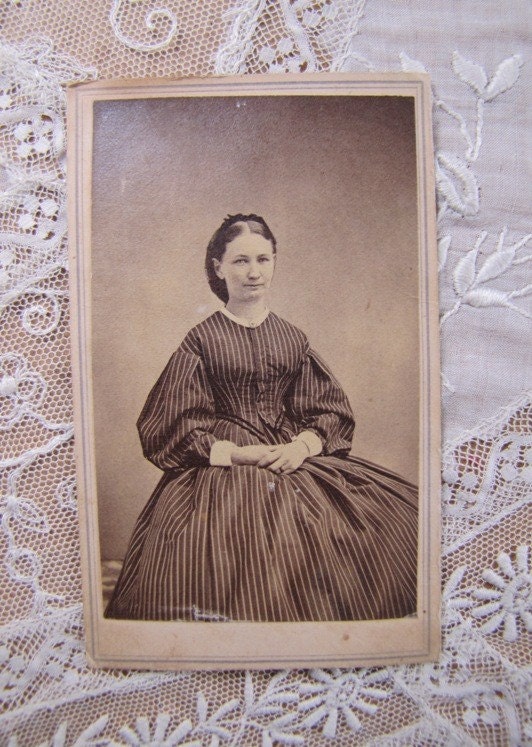Trying my hand at at copying 1860s photography.
Mostly inspired by the CDVs in my collection. Once I got to looking at all the different photographs, there was a lot of variety in pose - sitting, standing, looking/not looking, profile, props/no props....etc...
This CDV was my inspiration for lighting/background. Since I was taking the picture just against a white background, I wasn't getting the shadows and color variations often seen in the background color and edges of the CDVs. So, on my attempt I just shaded/shadowed/colored the photo by hand in Adobe Photoshop.
It would be fun to research it further and find out *what* was used for backdrops in 1860s carte-de-viste studios, and what lighting was commonly used. A knowledge of those two things would make it lots easier to more accuratly copy the look. I would love to play with techniques more and see if I could get something close enough to have an accurate enough look to use as small props at reenactments....
Any tips on reproducing old photos?




Lovely photo Atlanta!! (:
ReplyDeleteI have no tips for old photos.. but yours turned out really nice!!! It would be cool if you could add a bit of grain on the photo to make it look more 'old', you know? However, it does look very much like the one you showed. :)
ReplyDeleteThat must be lots of fun to create your own CDVs! Oh, and I wanted to ask, what website do you get lots of CDVs from? I had seen lots of people from SA using CDVs that they had pulled off of the internet.. however, I can't remember what the link was.. hehe!
Very cool! I've also gotten into trying to reproduce the look of old photography, and two things I have found to be very important are selective blur, and dirt. The dirt especially - dust, scratches, knicks on the card, water spotting, etc. I tried a CDV look here: http://pinterest.com/pin/274015958547705376/ and here: http://pinterest.com/pin/274015958547705381/
ReplyDeleteThe framing, also, especially with the CDVs can give that antique look. If you are using Photoshop, I can recommend a great plug-in called "Silver FX" that gives you control over film grain, soft focus, tint, filtering, etc., to mimic the effects of real black and white film.
Good luck!
No tips from me, but Lauren at American Duchess is doing a series on this sort of thing. I can't remember whether she's covered 1860s yet, but she definitely did some vintage 20th century.
ReplyDeleteAlso, a fact I remember randomly from somewhere - in the old photographs, thanks to the techniques used, the dark colours are often less dark in real life. I think there was something about red coming out as black? Would have to check, and I can't remember my source. Anyway, I think that's what makes these digitally manipulated modern photographs seem less authentic somehow, so if you could figure out a way to work that into yours...
Wow, that's so pretty! I love how your dress looks, too. Did you try any color conversion? (I mean, the way period cameras turned blues white and reds black, etc?)
ReplyDeleteI want to say that period photography studios used natural light. I suspect that like artist studios, they had lots of big windows and particularly skylights. That allows for light that comes from above, not just from the side. I'm sure they could have shades and other arrangements to keep from getting sun that's too bright or too direct as well.
Keeping experimenting - I love to see what you do!
Good job! :D
ReplyDeleteThat looks amazing!! How did you do your hair? It's gorgeous!
ReplyDeletePhoto Effect Studio and Flare both have some really good effects to make a photo look like a CDV. They're Apps on the app store...but if you have PC I'm not sure if they work with those apps. But I thought I'd throw that out there for you. :)
ReplyDeleteHope you guys are doing well! It's been ages since we've gotten to chat!